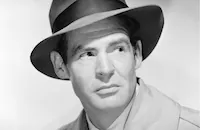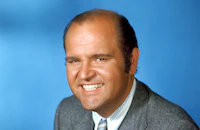The Busy Body
Cast & Crew
William Castle
Sid Caesar
Robert Ryan
Anne Baxter
Kay Medford
Jan Murray
Film Details
Technical Specs

Synopsis
Gang leader Charley Barker orders one of his flunkies, George Norton, to dig up the corpse of Archie Brody, a crime syndicate money collector, because Brody was buried in a blue suit that had $1,000,000 sewn in its lining. George digs up the body twice: the first time he finds an empty coffin. George tries again a few days later and finds the body of a total stranger. Suspicion points to the funeral parlor, but when both the mortician and his assistant are murdered, Barker, implying that George stole the money, has him "taken for a ride." George escapes, visits Brody's widow, an ex-stripper named Bobbi, and learns that her neighbors, the Fosters, are somehow involved. George's sleuthing proves that Margo Foster had attempted to pass off Brody's charred body as her husband in order to collect his insurance; and Murray Foster had killed the two morticians to insure secrecy. Once the couple are arrested, George returns to Bobbi's apartment and discovers that she is color blind--her husband had been buried in his brown suit, and the blue suit in his closet does not have any money sewn into its lining. It becomes apparent that Barker stole the syndicate's money himself and was also responsible for Brody's murder. The gang leader tries to kill George, but in a climactic rooftop struggle, George's possessive mother and Bobbi come to his rescue, and Barker falls to his death.

Director

William Castle
Cast

Sid Caesar

Robert Ryan

Anne Baxter

Kay Medford
Jan Murray

Richard Pryor

Arlene Golonka

Charles Mcgraw

Ben Blue

Dom Deluise

Godfrey Cambridge
Marty Ingels
Paul Wexler
Bill Dana
George Jessel
Audrie Magee
Mickey Deems
Choo Choo Collins

Marina Koshetz

Norman Bartold
Mike Wagner
Larry Gelman
Don Brodie
Crew
Roland Anderson
Robert R. Benton
Charles Bohart
Edwin H. Bryant
Frank Caffey
William Castle
Ray Cossar
Kenneth Deland
Andrew J. Durkus
Farciot Edouart
Arlene Golonka
Johnny Green
Edward Heyman
Dona Holloway
Paul K. Lerpae
Harold Lewis
Nellie Manley
Curtis Mick
Jack Mills
Vic Mizzy
Hedvig Mjorud
Hal Pereira
Al Roelofs
Ben Starr
Hal Stine
Monte Westmore
Wally Westmore
John Wilkinson

Film Details
Technical Specs

Articles
Richard Pryor (1940-2005)
He was born Richard Thomas Pryor III on December 1, 1940 in Peoria, Illinois. By all accounts, his childhood was a difficult one. His mother was a prostitute and his grandmother ran a brothel. His father was rarely around and when he was, he would physically abuse him. From a young age, Pryor knew that humor was his weapon of choice to cut through all the swath he came across and would confront in his life.
After high school, he enlisted in the Army for a two-year stint (1958-60). When he was discharged (honorably!) he concentrated on stand-up comedy and worked in a series of nightclubs before relocating to New York City in 1963. In 1964, he made his television debut when he was given a slot on the variety program On Broadway Tonight. His routine, though hardly the groundbreaking material we would witness in later years, was very well received, and in the late '60s Pryor found more television work: Toast of the Town, The Wild Wild West, The Mod Squad ; and was cast in a two movies: The Busy Body (1967) with Sid Caesar; and Wild in the Streets (1968) a cartoonish political fantasy about the internment of all American citizens over 30.
Pryor's career really didn't ignite until the '70s. His stand up act became raunchier and more politically motivated as he touched on issued of race, failed relationships, drug addiction, and street crimes. His movie roles became far more captivating in the process: the piano man in Lady Sings the Blues (1972); as a wise-talking hustler in a pair of slick urban thrillers: The Mack (1973) and Uptown Saturday Night (1974); the gregarious Daddy Rich in Car Wash; his first pairing with Gene Wilder as Grover, the car thief who helps stops a runaway train in his first real box office smash Silver Streak (both 1976); and for many critics, his finest dramatic performance as a factory worker on the edge of depression in Paul Schrader's excellent working class drama Blue Collar (1978).
On a personal level, his drug dependency problem worsened, and on June 9, 1980, near tragedy struck when he caught fire while free-basing cocaine. Pryor later admitted that the incident, was, in fact, a suicide attempt, and that his management company created the lie for the press in hopes of protecting him. Fortunately, Pryor had three films in the can that all achieved some level of financial success soon after his setback: another pairing with Gene Wilder in the prison comedy Stir Crazy (1980); a blisteringly funny cameo as God who flips off Andy Kaufman in the warped religious satire In God We Tru$t (1980); an a ex-con helping a social worker (Cicely Tyson) with her foster charges in Bustin' Loose (1981). He capped his recovery with Live on the Sunset Strip (1982), a first-rate documentation of the comic's genius performed in front of a raucous live audience.
In 1983, Pryor signed a $40 million, five-year contract with Columbia Pictures. For many fans and critics, this was the beginning of his downslide. His next few films: The Toy, Superman III (both 1983), and Brewster's Millions (1985) were just tiresome, mediocre comedies. Jo Jo Dancer, Your Life is Calling (1986), was his only attempt at producing, directing, and acting, and the film, which was an ambitious autobiographical account of a his life and career, was a box-office disappointment. He spent the remainder of the '80s in middling fare: Condition Critical (1987), Moving; a third pairing with Gene Wilder in See No Evil, Hear No Evil; and his only teaming with Eddie Murphy in Harlem Nights (1989).
In 1986, Pryor was diagnosed with multiple sclerosis, a degenerative disease of the nervous system that curtailed both his personal appearances and his gift for physical comedy in his latter films. By the '90s, little was seen of Pryor, but in 1995, he made a courageous comeback on television when he guest starred on Chicago Hope as an embittered multiple sclerosis patient. His performance earned him an Emmy nomination and he was cast in a few more films: Mad Dog Time (1996), Lost Highway (1997), but his physical ailments prohibited him from performing on a regular basis. In 1998, The John F. Kennedy Center for the Performing Arts in Washington gave Pryor the first Mark Twain Prize for humor. It was fitting tribute for a man who had given so much honesty and innovation in the field of comedy. Pryor is survived by his wife, Jennifer Lee; his sons Richard and Steven; and daughters Elizabeth, Rain and Renee.
by Michael T. Toole

Richard Pryor (1940-2005)
Quotes
Trivia
Notes
Location scenes for the film were shot in Chicago. The Busy Body marked the film debut for actor-comedian Richard Pryor (1940-2005).

Miscellaneous Notes
Released in United States Winter January 13, 1967
Richard Pryor's screen debut.
Techniscope
Released in United States Winter January 13, 1967













